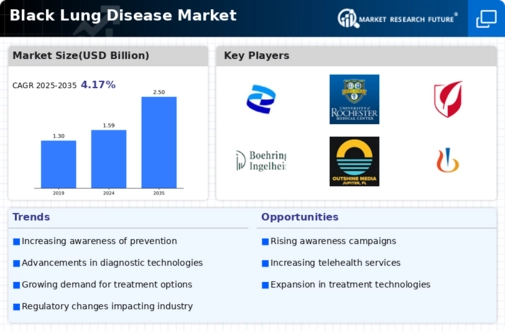Market Growth Projections
The Global Black Lung Disease Market Industry is projected to experience substantial growth over the coming years. With an estimated market value of 1.59 USD Billion in 2024, it is expected to reach 2.5 USD Billion by 2035, reflecting a compound annual growth rate (CAGR) of 4.2% from 2025 to 2035. This growth trajectory indicates a rising demand for diagnostic and therapeutic solutions as awareness of Black Lung Disease continues to expand. Factors such as increased prevalence, advancements in technology, and supportive government policies contribute to this positive outlook, suggesting a robust future for the industry.
Growing Awareness and Advocacy
The rise in awareness and advocacy surrounding Black Lung Disease significantly impacts the Global Black Lung Disease Market Industry. Advocacy groups are actively working to educate the public and policymakers about the risks associated with coal mining and the importance of early detection and treatment. This heightened awareness leads to increased demand for healthcare services and products aimed at managing the disease. As more individuals seek medical attention and support, the market is poised for growth, with projections indicating a value of 1.59 USD Billion in 2024. The collective efforts of advocacy organizations play a crucial role in driving this market forward.
Government Regulations and Support
Government regulations aimed at protecting workers in hazardous occupations play a pivotal role in shaping the Global Black Lung Disease Market Industry. Legislative measures, such as stricter air quality standards and mandatory health screenings for coal miners, are being implemented to mitigate the risks associated with coal dust exposure. These regulations not only enhance worker safety but also drive demand for related healthcare services and products. The market is projected to grow at a CAGR of 4.2% from 2025 to 2035, indicating that ongoing regulatory support will likely continue to influence market dynamics positively.
Advancements in Diagnostic Technologies
Technological advancements in diagnostic tools significantly influence the Global Black Lung Disease Market Industry. Innovations such as high-resolution computed tomography (HRCT) and digital radiography enhance the accuracy of diagnosing Black Lung Disease, leading to earlier detection and treatment. These advancements not only improve patient outcomes but also drive market growth, as healthcare providers increasingly adopt these technologies. The anticipated growth of the market to 2.5 USD Billion by 2035 suggests a robust demand for advanced diagnostic solutions. As healthcare systems worldwide prioritize early intervention, the integration of cutting-edge technologies becomes crucial in addressing this public health concern.
Rising Prevalence of Black Lung Disease
The increasing prevalence of Black Lung Disease among coal miners is a primary driver of the Global Black Lung Disease Market Industry. As more cases are reported, particularly in regions with high coal mining activity, the demand for diagnostic and therapeutic solutions rises. In 2024, the market is valued at approximately 1.59 USD Billion, reflecting the urgent need for effective management and treatment options. The rise in awareness regarding occupational health risks associated with coal mining further propels this market, as stakeholders seek to implement preventive measures and improve the health outcomes of affected individuals.
Increased Funding for Research and Treatment
The Global Black Lung Disease Market Industry benefits from increased funding directed towards research and treatment initiatives. Government and non-profit organizations are investing in studies aimed at understanding the disease's pathophysiology and developing effective therapies. This influx of funding fosters innovation in treatment options, which may lead to improved patient care and outcomes. As awareness of Black Lung Disease grows, so does the commitment to addressing its impact on affected populations. The anticipated market growth to 2.5 USD Billion by 2035 underscores the potential for research-driven advancements to reshape the landscape of care for this condition.























Leave a Comment